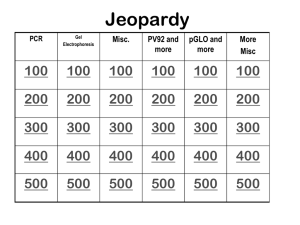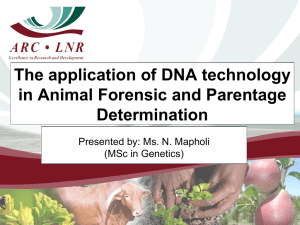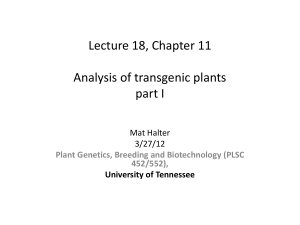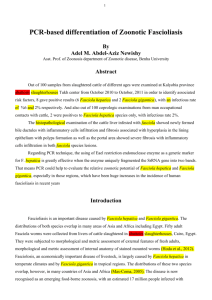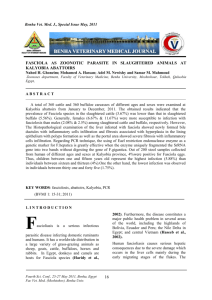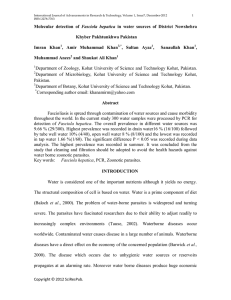Fasciola
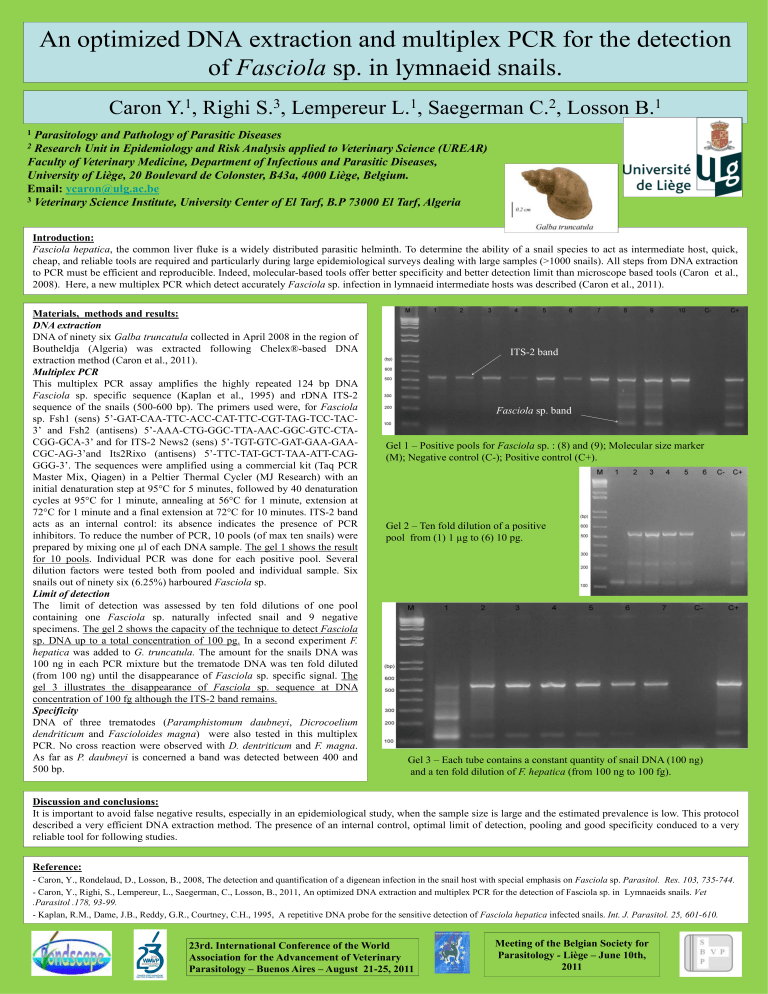
An optimized DNA extraction and multiplex PCR for the detection of Fasciola sp. in lymnaeid snails.
Caron Y.
1
, Righi S.
3
, Lempereur L.
1
, Saegerman C.
2
, Losson B.
1
1 Parasitology and Pathology of Parasitic Diseases
2 Research Unit in Epidemiology and Risk Analysis applied to Veterinary Science (UREAR)
Faculty of Veterinary Medicine, Department of Infectious and Parasitic Diseases,
University of Liège, 20 Boulevard de Colonster, B43a, 4000 Liège, Belgium.
3
Email: ycaron@ulg.ac.be
Veterinary Science Institute, University Center of El Tarf, B.P 73000 El Tarf, Algeria
Introduction:
Fasciola hepatica
, the common liver fluke is a widely distributed parasitic helminth. To determine the ability of a snail species to act as intermediate host, quick, cheap, and reliable tools are required and particularly during large epidemiological surveys dealing with large samples (>1000 snails). All steps from DNA extraction to PCR must be efficient and reproducible. Indeed, molecular-based tools offer better specificity and better detection limit than microscope based tools (Caron et al.,
2008). Here, a new multiplex PCR which detect accurately
Fasciola
sp. infection in lymnaeid intermediate hosts was described (Caron et al., 2011).
Materials, methods and results:
DNA extraction
DNA of ninety six
Galba truncatula
collected in April 2008 in the region of
Boutheldja (Algeria) was extracted following Chelex®-based DNA extraction method (Caron et al., 2011).
Multiplex PCR
This multiplex PCR assay amplifies the highly repeated 124 bp DNA
Fasciola
sp. specific sequence (Kaplan et al., 1995) and rDNA ITS-2 sequence of the snails (500-600 bp). The primers used were, for
Fasciola
sp. Fsh1 (sens) 5’-GAT-CAA-TTC-ACC-CAT-TTC-CGT-TAG-TCC-TAC-
3’ and Fsh2 (antisens) 5’-AAA-CTG-GGC-TTA-AAC-GGC-GTC-CTA-
CGG-GCA-3’ and for ITS-2 News2 (sens) 5’-TGT-GTC-GAT-GAA-GAA-
CGC-AG-3’and Its2Rixo (antisens) 5’-TTC-TAT-GCT-TAA-ATT-CAG-
GGG-3’. The sequences were amplified using a commercial kit (Taq PCR
Master Mix, Qiagen) in a Peltier Thermal Cycler (MJ Research) with an initial denaturation step at 95°C for 5 minutes, followed by 40 denaturation cycles at 95°C for 1 minute, annealing at 56°C for 1 minute, extension at
72°C for 1 minute and a final extension at 72°C for 10 minutes. ITS-2 band acts as an internal control: its absence indicates the presence of PCR inhibitors. To reduce the number of PCR, 10 pools (of max ten snails) were prepared by mixing one µl of each DNA sample. The gel 1 shows the result for 10 pools. Individual PCR was done for each positive pool. Several dilution factors were tested both from pooled and individual sample. Six snails out of ninety six (6.25%) harboured
Fasciola
sp.
Limit of detection
The limit of detection was assessed by ten fold dilutions of one pool containing one
Fasciola
sp. naturally infected snail and 9 negative specimens. The gel 2 shows the capacity of the technique to detect
Fasciola
sp. DNA up to a total concentration of 100 pg. In a second experiment
F.
hepatica
was added to
G. truncatula.
The amount for the snails DNA was
100 ng in each PCR mixture but the trematode DNA was ten fold diluted
(from 100 ng) until the disappearance of
Fasciola
sp. specific signal. The gel 3 illustrates the disappearance of
Fasciola
sp. sequence at DNA concentration of 100 fg although the ITS-2 band remains.
Specificity
DNA of three trematodes (
Paramphistomum daubneyi
,
Dicrocoelium dendriticum
and
Fascioloides magna
) were also tested in this multiplex
PCR. No cross reaction were observed with
D. dentriticum
and
F. magna
.
As far as
P. daubneyi
is concerned a band was detected between 400 and
500 bp.
Gel 1 – Positive pools for
ITS-2 band
Fasciola
Fasciola sp. band
sp. : (8) and (9); Molecular size marker
(M); Negative control (C-); Positive control (C+).
Gel 2 – Ten fold dilution of a positive pool from (1) 1 µg to (6) 10 pg.
Gel 3 – Each tube contains a constant quantity of snail DNA (100 ng) and a ten fold dilution of
F. hepatica
(from 100 ng to 100 fg).
Discussion and conclusions:
It is important to avoid false negative results, especially in an epidemiological study, when the sample size is large and the estimated prevalence is low. This protocol described a very efficient DNA extraction method. The presence of an internal control, optimal limit of detection, pooling and good specificity conduced to a very reliable tool for following studies.
Reference:
- Caron, Y., Rondelaud, D., Losson, B., 2008, The detection and quantification of a digenean infection in the snail host with special emphasis on
Fasciola
sp.
Parasitol. Res. 103, 735-744.
- Caron, Y., Righi, S., Lempereur, L., Saegerman, C., Losson, B., 2011, An optimized DNA extraction and multiplex PCR for the detection of Fasciola sp. in Lymnaeids snails.
Vet
.Parasitol .178, 93-99.
- Kaplan, R.M., Dame, J.B., Reddy, G.R., Courtney, C.H., 1995, A repetitive DNA probe for the sensitive detection of
Fasciola hepatica
infected snails.
Int. J. Parasitol. 25, 601-610.
23rd. International Conference of the World
Association for the Advancement of Veterinary
Parasitology – Buenos Aires – August 21-25, 2011
Meeting of the Belgian Society for
Parasitology - Liège – June 10th,
2011

